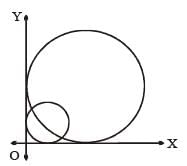JEE Exam > JEE Questions > Two circles of radii r1 and r2 are both touch...
Start Learning for Free
Two circles of radii r1 and r2 are both touching the coordinate axes and intersecting each other orthogonally. The value of r1/r2 (where r1 > r2) equals
- a)2 + √3
- b)√3 + 1
- c)2 – √3
- d)2 + √5
Correct answer is option 'A'. Can you explain this answer?
Verified Answer
Two circles of radii r1 and r2 are both touching the coordinate axes a...
Circle is (x – r)2 + (y – r)2 = r2
⇒ x2 + y2 – 2xr – 2yr + r2 = 0
Hence the circles are x2 + y2 – 2xr1 – 2yr1 + r12 = 0 ......(1)

x2 + y2 – 2xr2 – 2yr2 + r22 = 0 .....(2)
As (1) and (2) are orthogonal so
2r1r2 + 2r1r2 = r12 + r22
⇒ x2 + y2 – 2xr – 2yr + r2 = 0
Hence the circles are x2 + y2 – 2xr1 – 2yr1 + r12 = 0 ......(1)

x2 + y2 – 2xr2 – 2yr2 + r22 = 0 .....(2)
As (1) and (2) are orthogonal so
2r1r2 + 2r1r2 = r12 + r22


Most Upvoted Answer
Two circles of radii r1 and r2 are both touching the coordinate axes a...
Let the centers of the circles be A and B, with coordinates (r1, r1) and (-r2, -r2) respectively.
Since the circles are orthogonal, the distance between their centers is equal to the sum of their radii. Using the distance formula, we have:
√[(r1 - (-r2))^2 + (r1 - (-r2))^2] = r1 + r2
√[(r1 + r2)^2 + (r1 + r2)^2] = r1 + r2
√[2(r1 + r2)^2] = r1 + r2
√2(r1 + r2) = r1 + r2
√2 = 1 + r1/r2
Squaring both sides of the equation, we get:
2 = (1 + r1/r2)^2
2 = 1 + 2(r1/r2) + (r1/r2)^2
Rearranging the terms, we have:
(r1/r2)^2 + 2(r1/r2) - 1 = 0
Let x = r1/r2. Substituting this into the equation, we have:
x^2 + 2x - 1 = 0
Using the quadratic formula, we can solve for x:
x = (-b ± √(b^2 - 4ac))/2a
In this case, a = 1, b = 2, and c = -1. Plugging in these values, we get:
x = (-2 ± √(2^2 - 4(1)(-1)))/2(1)
x = (-2 ± √(4 + 4))/2
x = (-2 ± √8)/2
x = (-2 ± 2√2)/2
x = -1 ± √2
Since r1 and r2 are both positive, we take the positive value of x:
x = -1 + √2
Therefore, r1/r2 = -1 + √2.
Since the circles are orthogonal, the distance between their centers is equal to the sum of their radii. Using the distance formula, we have:
√[(r1 - (-r2))^2 + (r1 - (-r2))^2] = r1 + r2
√[(r1 + r2)^2 + (r1 + r2)^2] = r1 + r2
√[2(r1 + r2)^2] = r1 + r2
√2(r1 + r2) = r1 + r2
√2 = 1 + r1/r2
Squaring both sides of the equation, we get:
2 = (1 + r1/r2)^2
2 = 1 + 2(r1/r2) + (r1/r2)^2
Rearranging the terms, we have:
(r1/r2)^2 + 2(r1/r2) - 1 = 0
Let x = r1/r2. Substituting this into the equation, we have:
x^2 + 2x - 1 = 0
Using the quadratic formula, we can solve for x:
x = (-b ± √(b^2 - 4ac))/2a
In this case, a = 1, b = 2, and c = -1. Plugging in these values, we get:
x = (-2 ± √(2^2 - 4(1)(-1)))/2(1)
x = (-2 ± √(4 + 4))/2
x = (-2 ± √8)/2
x = (-2 ± 2√2)/2
x = -1 ± √2
Since r1 and r2 are both positive, we take the positive value of x:
x = -1 + √2
Therefore, r1/r2 = -1 + √2.

|
Explore Courses for JEE exam
|

|
Similar JEE Doubts
Question Description
Two circles of radii r1 and r2 are both touching the coordinate axes and intersecting each other orthogonally. The value of r1/r2(where r1 > r2) equalsa)2 + √3b)√3 + 1c)2 – √3d)2 + √5Correct answer is option 'A'. Can you explain this answer? for JEE 2025 is part of JEE preparation. The Question and answers have been prepared according to the JEE exam syllabus. Information about Two circles of radii r1 and r2 are both touching the coordinate axes and intersecting each other orthogonally. The value of r1/r2(where r1 > r2) equalsa)2 + √3b)√3 + 1c)2 – √3d)2 + √5Correct answer is option 'A'. Can you explain this answer? covers all topics & solutions for JEE 2025 Exam. Find important definitions, questions, meanings, examples, exercises and tests below for Two circles of radii r1 and r2 are both touching the coordinate axes and intersecting each other orthogonally. The value of r1/r2(where r1 > r2) equalsa)2 + √3b)√3 + 1c)2 – √3d)2 + √5Correct answer is option 'A'. Can you explain this answer?.
Two circles of radii r1 and r2 are both touching the coordinate axes and intersecting each other orthogonally. The value of r1/r2(where r1 > r2) equalsa)2 + √3b)√3 + 1c)2 – √3d)2 + √5Correct answer is option 'A'. Can you explain this answer? for JEE 2025 is part of JEE preparation. The Question and answers have been prepared according to the JEE exam syllabus. Information about Two circles of radii r1 and r2 are both touching the coordinate axes and intersecting each other orthogonally. The value of r1/r2(where r1 > r2) equalsa)2 + √3b)√3 + 1c)2 – √3d)2 + √5Correct answer is option 'A'. Can you explain this answer? covers all topics & solutions for JEE 2025 Exam. Find important definitions, questions, meanings, examples, exercises and tests below for Two circles of radii r1 and r2 are both touching the coordinate axes and intersecting each other orthogonally. The value of r1/r2(where r1 > r2) equalsa)2 + √3b)√3 + 1c)2 – √3d)2 + √5Correct answer is option 'A'. Can you explain this answer?.
Solutions for Two circles of radii r1 and r2 are both touching the coordinate axes and intersecting each other orthogonally. The value of r1/r2(where r1 > r2) equalsa)2 + √3b)√3 + 1c)2 – √3d)2 + √5Correct answer is option 'A'. Can you explain this answer? in English & in Hindi are available as part of our courses for JEE.
Download more important topics, notes, lectures and mock test series for JEE Exam by signing up for free.
Here you can find the meaning of Two circles of radii r1 and r2 are both touching the coordinate axes and intersecting each other orthogonally. The value of r1/r2(where r1 > r2) equalsa)2 + √3b)√3 + 1c)2 – √3d)2 + √5Correct answer is option 'A'. Can you explain this answer? defined & explained in the simplest way possible. Besides giving the explanation of
Two circles of radii r1 and r2 are both touching the coordinate axes and intersecting each other orthogonally. The value of r1/r2(where r1 > r2) equalsa)2 + √3b)√3 + 1c)2 – √3d)2 + √5Correct answer is option 'A'. Can you explain this answer?, a detailed solution for Two circles of radii r1 and r2 are both touching the coordinate axes and intersecting each other orthogonally. The value of r1/r2(where r1 > r2) equalsa)2 + √3b)√3 + 1c)2 – √3d)2 + √5Correct answer is option 'A'. Can you explain this answer? has been provided alongside types of Two circles of radii r1 and r2 are both touching the coordinate axes and intersecting each other orthogonally. The value of r1/r2(where r1 > r2) equalsa)2 + √3b)√3 + 1c)2 – √3d)2 + √5Correct answer is option 'A'. Can you explain this answer? theory, EduRev gives you an
ample number of questions to practice Two circles of radii r1 and r2 are both touching the coordinate axes and intersecting each other orthogonally. The value of r1/r2(where r1 > r2) equalsa)2 + √3b)√3 + 1c)2 – √3d)2 + √5Correct answer is option 'A'. Can you explain this answer? tests, examples and also practice JEE tests.

|
Explore Courses for JEE exam
|

|
Signup to solve all Doubts
Signup to see your scores go up within 7 days! Learn & Practice with 1000+ FREE Notes, Videos & Tests.




























